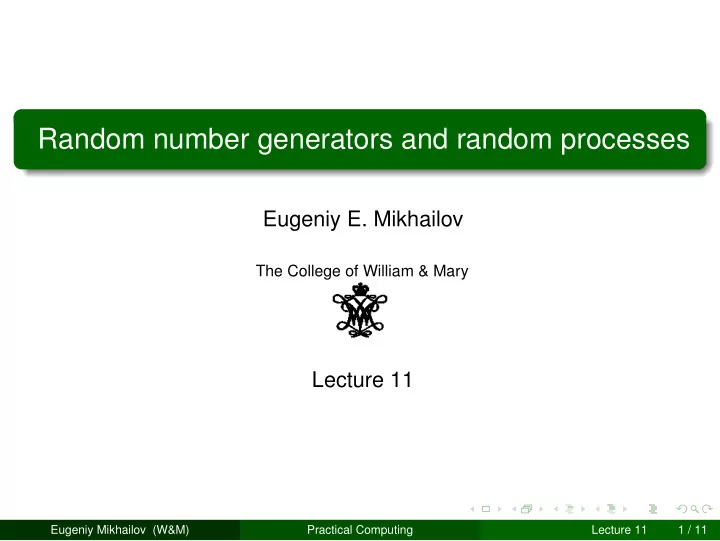

Random number generators and random processes Eugeniy E. Mikhailov The College of William & Mary Lecture 11 Eugeniy Mikhailov (W&M) Practical Computing Lecture 11 1 / 11
Statistics and probability intro Mathematical and physical definition of probability ( p ) of event ’x’ N x p x = lim N total N total →∞ where N x the number of registered event ’x’ N total the total number of all events Eugeniy Mikhailov (W&M) Practical Computing Lecture 11 2 / 11
Peg board example Eugeniy Mikhailov (W&M) Practical Computing Lecture 11 3 / 11
Peg board example Eugeniy Mikhailov (W&M) Practical Computing Lecture 11 3 / 11
Peg board example Eugeniy Mikhailov (W&M) Practical Computing Lecture 11 3 / 11
Peg board example Eugeniy Mikhailov (W&M) Practical Computing Lecture 11 3 / 11
Peg board example Eugeniy Mikhailov (W&M) Practical Computing Lecture 11 3 / 11
Peg board example Eugeniy Mikhailov (W&M) Practical Computing Lecture 11 3 / 11
Peg board example Example of 10 4 balls runs over 40 layers of nails x=pegboard(10^4, 40); hist(x, [-25:25]); 1400 1200 1000 800 600 400 200 0 -20 -10 0 10 20 Resulting distribution is Gaussian Eugeniy Mikhailov (W&M) Practical Computing Lecture 11 3 / 11
Probability for occurrence of the real number It is well known that interval [ 0 .. 1 ] has infinite amount of reals numbers (as well as any other non zero interval). So there is very little or may be zero chance that event will repeat or even happen. Since we cannot run ∞ number of tests. In this case we should speak about probability density p ( x ) . The best way to estimate it is from a histogram. Run you N tests with numbers distributed between 0 and 1. Split you interval at m bins and calculate number of events when you hit each bin h ( x b ) . Plot this vs bin positions. Easy to do with Matlab r = rand ( 1 , N ); hist ( r , m ); Then h ( x b nearest to x ) p ( x ) = lim N N , m →∞ Eugeniy Mikhailov (W&M) Practical Computing Lecture 11 4 / 11
Uniform random distribution r = rand ( 1 , 10000 ); r = rand ( 1 , 10000 ); hist ( r , 10 ); hist ( r , 100 ); 1200 140 120 1000 100 800 80 600 60 400 40 200 20 0 0 0 0.2 0.4 0.6 0.8 1 0 0.2 0.4 0.6 0.8 1 Eugeniy Mikhailov (W&M) Practical Computing Lecture 11 5 / 11
Random number generators How can a computer, which is very accurate, precise, and deterministic, generate random numbers? It cannot! Instead we can generate a sequence of pseudo random numbers. By pseudo we mean that starting from the same initial conditions the computer will generate the same sequence of numbers ( very handy for debugging ). But otherwise it will look like random numbers and will have statistical properties of random numbers. Eugeniy Mikhailov (W&M) Practical Computing Lecture 11 6 / 11
Linear Congruential Generator (LCG) Recursive formula r i + 1 = ( ar i + c ) mod m here m the modulus a multiplier, 0 < a < m c increment, c ≤ c < m r 1 seed value, 0 ≤ r 1 < m All pseudo random generators have a period and this one is no exception. Note that once r i repeat one of the previews values the sequence will restart. This one can have at most a period of m distinct numbers (0.. m ). Eugeniy Mikhailov (W&M) Practical Computing Lecture 11 7 / 11
Linear Congruential Generator (LCG) continued Bad choice of a , c , m will lead to even shorter periods. Example m = 10, a = 2, c = 1 , r 1 = 1 r = [ 1 , 3 , 7 , 5 , 1 ] While the LCG has advantage of speed and simplicity. Do not use the LCG whenever your money or reputation are at stakes! While Matlab does not use LCG, many other programming languages use it as default in their libraries so be aware of it. Eugeniy Mikhailov (W&M) Practical Computing Lecture 11 8 / 11
Random number generators period Even the best pseudo random generators cannot have a period larger than 2 B , where B is number of memory bits. Can you prove it? While the period can be huge its not infinite. For example for Matlab R2007a the period is 2 19937 − 1. Why bother? Recall that for example error of the Monte Carlo integration method is √ ∼ 1 / N . This holds true only when N < than the period of random number generator ( T ). Otherwise the MC method cannot give uncertainty better than √ ∼ 1 / T . Further increase of the number of random points will not bring any any extra improvement. Eugeniy Mikhailov (W&M) Practical Computing Lecture 11 9 / 11
How to check the random generator Generally it is uneasy and probably impossible. However for us only statistical properties are of importance. So the easiest is to check that integral deviation calculated with Monte √ Carlo algorithm drops as 1 / N . Eugeniy Mikhailov (W&M) Practical Computing Lecture 11 10 / 11
Simple LCG check Let’s see how the LCG will look with very bad coefficient function r= ... m = 10, a = 2, c = 1 , r 1 = 1 lcgrand(Nrows,Ncols, ... a,c,m, seed) 10 0 r=zeros(Nrows, Ncols); 10 -1 r(1)=seed; 10 -2 cntr=1; for i=2:Nrows*Ncols; 10 -3 r(i)= mod( (a*r(i-1)+c), m); 10 -4 10 1 10 2 10 3 10 4 10 5 end r=r/(m-1); %normalization end Lines are fro MC with rand and line-crosses for check_lcgrand lcgrand (Nrows, Ncols, 2,1,10); Eugeniy Mikhailov (W&M) Practical Computing Lecture 11 11 / 11
Recommend
More recommend